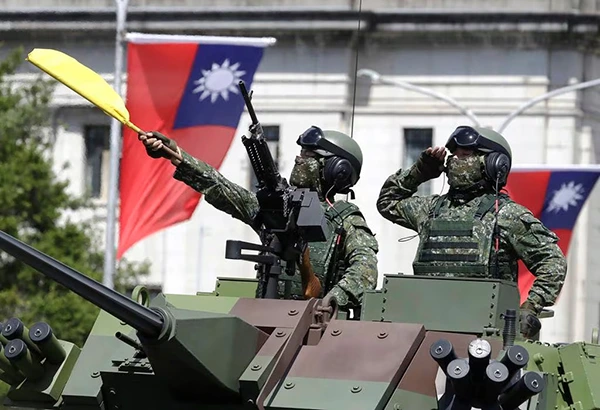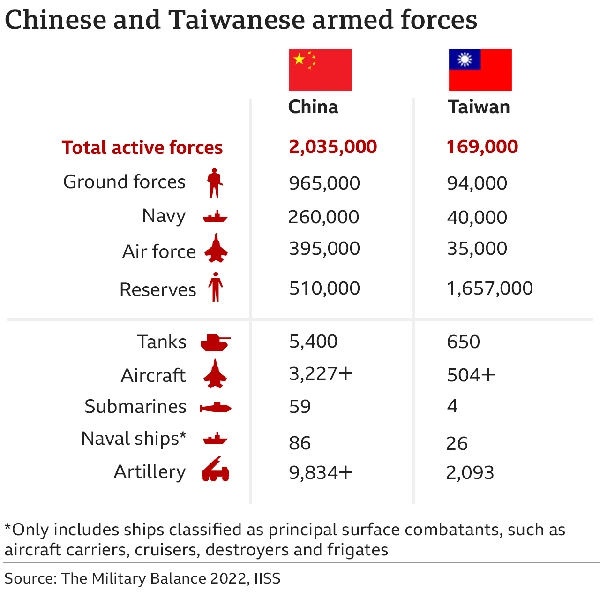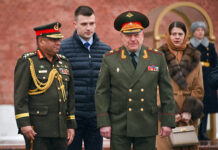
Invasion of Taiwan – Part 5
The circumstances under which the PRC has historically indicated it would consider the use force have evolved over time. These circumstances have included:
• Formal declaration of Taiwan independence;
• Undefined moves toward Taiwan independence;
• Internal unrest in Taiwan;
• Taiwan’s acquisition of nuclear weapons;
• Indefinite delays in the resumption of cross-Strait dialogue on unification;
• Foreign military intervention in Taiwan’s internal affairs.
• Article 8 of the PRC’s March 2005 Anti-Secession Law states that the PRC may use “non-peaceful means” if “secessionist forces … cause the fact of Taiwan’s secession from China,” if “major incidents entailing Taiwan’s secession” occur, or if “possibilities for peaceful reunification” are exhausted. The PRC’s use of such non-specific conditions increases their policy flexibility through deliberate strategic ambiguity.
China’s Courses of Action Against Taiwan
The PRC continues to signal its willingness to use military force against Taiwan. The PLA has a range of options to coerce Taipei based on its increasing capabilities in multiple domains. The PRC could pursue a measured approach by signaling its readiness to use force or conduct punitive actions against Taiwan. The PLA could also conduct a more comprehensive campaign designed to force Taiwan to capitulate to unification, or attempt to compel Taiwan’s leadership to the negotiation table under Beijing’s terms. Notably, the PRC would seek to deter potential U.S. intervention in any Taiwan contingency campaign – capabilities relevant to deterring or countering potential U.S. intervention were among those that the PRC highlighted during its October 2019 military parade celebrating its 70th anniversary. Failing that, the PRC would attempt to delay and defeat intervention in a limited war of short duration. In the event of a protracted conflict, the PLA might choose to escalate cyberspace, space, or nuclear activities in an attempt to end the conflict, or it might choose to fight to a stalemate and pursue a political settlement. The PLA could offer the following military options against Taiwan, listed below individually or in combination, with varying degrees of feasibilities and risk associated.
Air and Maritime Blockade. PLA writings describe a Joint Blockade Campaign in which the PRC would employ blockades of maritime and air traffic, including a cut-off of Taiwan’s vital imports, to force Taiwan’s capitulation. Large-scale missile strikes and possible seizures of Taiwan’s offshore islands would accompany a Joint Blockade Campaign in an attempt to compel Taiwan’s surrender, while at the same time, posturing air and naval forces to conduct weeks or months of blockade operations if necessary. The PRC likely will complement its air and maritime blockades with concurrent electronic warfare (EW), network attacks, and information operations (IO) to further isolate Taiwan’s authorities and populace and to control the international narrative of the conflict.
Limited Force or Coercive Options. The PRC could use a variety of disruptive, punitive, or lethal military actions in a limited campaign against Taiwan, probably in conjunction with overt and clandestine economic and political activities supported by a variety of information operations to shape perceptions or undercut the effectiveness or legitimacy of the Taiwan authorities. Such a campaign could include computer network or limited kinetic attacks against Taiwan’s political, military, and economic infrastructure to induce fear in Taiwan and degrade the Taiwan population’s confidence in their leaders. Similarly, PLA special operations forces (SOF) could infiltrate Taiwan and conduct attacks against infrastructure or leadership targets.
Air and Missile Campaign. The PRC could use precision missile and air strikes against key government and military targets, including air bases, radar sites, missiles, space assets, and communications facilities to degrade Taiwan’s defenses, neutralize Taiwan’s leadership, or undermine the public’s resolve to resist.
Invasion of Taiwan. PRC writings describe different operational concepts for an amphibious invasion of Taiwan. The most prominent of these, the Joint Island Landing Campaign, envisions a complex operation relying on coordinated, interlocking campaigns for EW, logistics, air, and naval support. The objectives are to break through or circumvent shore defenses, establish a beachhead, build up combat power along Taiwan’s western coastline, and seize key targets or the entire island.
The PRC continues to build and exercise capabilities that would likely contribute to a full- scale invasion. In 2021, the PLA conducted joint amphibious assault exercises near Taiwan and completed construction of its third LHA. In addition to this capability, the PLA likely will augment their capabilities with civilian “roll on/roll off” ships, under the legal basis of the 2016 National Defense Transportation Law. The PLA experimented with launching amphibious assault vehicles from these civilian ships in July 2020 and summer 2021, allowing them to flow amphibious forces directly to the beach rather than disembarking at port facilities.
Large-scale amphibious invasion is one of the most complicated and difficult military operations, requiring air and maritime superiority, the rapid buildup and sustainment of supplies onshore, and uninterrupted support. An attempt to invade Taiwan would likely strain PRC’s armed forces and invite international intervention. Combined with inevitable force attrition, complexity of urban warfare, and potential insurgency, these factors make an amphibious invasion of Taiwan a significant political and military risk for Xi Jinping and the Chinese Communist Party, even assuming a successful landing and breakout.
The PLA is capable of various amphibious operations short of a full-scale invasion of Taiwan. With few overt military preparations beyond routine training, the PRC could launch an invasion of small Taiwan-occupied islands in the South China Sea such as Pratas or Itu Aba. A PLA invasion of a medium-sized, better-defended island such as Matsu or Kinmen is within the PLA’s capabilities. Such an invasion would demonstrate military capability, political resolve, and achieve tangible territorial gain while simultaneously showing some measure of restraint. This kind of operation involves significant, and possibly prohibitive, political risk because it could galvanize pro-independence sentiment on Taiwan and generate powerful international opposition.
Taiwan’s Options
In October 2021, Taiwan President Tsai Ing-Wen called for a building of consensus around four commitments:
1) to a free and democratic constitutional system;
2) that Taiwan and China should not be subordinate to each other;
3) to resist annexation or encroachment upon the island’s sovereignty, and
4) that Taiwan’s future be decided in accordance with the will of its people.
Taiwan has positioned itself as “a beacon of democracy” to generate international support and expand regional security ties. Taiwan is taking steps to compensate for the growing disparity with the PLA, including building its war reserve stocks, growing its defense-industrial base, improving joint operations and crisis response capabilities, and strengthening its officer and noncommissioned officer corps. Taiwan’s Quadrennial Defense Review 2021 reflects adjustments to the military’s strategy for defending the island by placing emphasis on protecting its littorals and near-shore coastal areas in a multi-layered defense-in-depth. The modified strategy stresses enhanced asymmetric and joint capabilities, as well as suggesting greater reliance on Taiwan’s Air Force and Navy through multi-domain deterrence measures.
In 2022, Russia’s war on Ukraine and the PRC’s forceful response to then-U.S. Speaker of the House’s delegation to Taiwan in August increased the urgency with which Taiwan is pursuing defense reforms. The PRC’s response to the then-U.S. House Speaker’s visit accelerated the PRC’s ongoing military and gray zone activity toward Taiwan. The PRC’s actions likely intended to establish a new status quo and to place greater operational demands on Taiwan’s military. Taiwan’s planned improvements only partially address its defense challenges, and a majority of Taiwan citizens believe that the then-Speaker’s visit and the PLA response were detrimental to Taiwan’s security.
Taiwan’s armed forces are authorized to fill approximately 215,000 billets, including 188,000 active-duty billets. As of 2021, the MND had accomplished its goal to fill 90 percent of the active duty billets (169,000) with volunteers. As Taiwan transitions to an all-volunteer force, the cost savings from manpower reductions provided some margin to improve individual pay and benefits, housing, and incentive pay. However, these savings have been insufficient to cover the full increase in manpower-related costs needed to attract and retain personnel under the new system. Taiwan also faces considerable equipment and readiness obstacles.
Reservists, conscripts, and civil defense volunteers support the volunteer active duty forces. Taiwan’s number of reserve personnel ranges from one to two million, while there are fewer than half a million conscripts. In 2021, Taiwan passed legislation to establish an organization to improve the mobilization of reserves and civilians to support military operations. In 2022, Taiwan implemented this legislation by establishing the All Out Defense Mobilization Agency, which coordinates a whole-of-society approach to support military operations and disaster prevention and response. In December 2022, Taiwan announced that it would extend the duration of mandatory military conscription service from four months to one year and double conscripts’ monthly salary starting in 2024.
Taiwan continues to increase its defense budget to support defense acquisitions and strengthen its forces against Chinese pressure. In 2020, the Tsai administration announced defense spending to be the highest level since 1990. In October 2022, Taiwan proposed total defense spending of about $19 billion for 2023, a 13.9 percent increase from 2022, which will represent about 2.4 percent of Taiwan’s GDP. In January 2022, Taiwan approved an $8 billion multi-year supplemental defense budget to strengthen Taiwan’s air and sea combat capabilities. Over half of Taiwan’s supplemental defense spending will fund missile corvettes and anti-ship weapons, such as the Hsiung Feng missile system. Meanwhile, China’s official defense budget continues to grow to around $230 billion in 2022, about 12 times larger than Taiwan’s defense budget, with much of China’s defense budget focused on developing the capability to unify Taiwan with the PRC by force.
Recognizing the growing disparity between their respective defense expenditures, Taiwan has stated that it is working to develop new cost effective concepts and capabilities for asymmetric warfare. Specific areas of emphasis in Taiwan’s strategy include offensive and defensive information and electronic warfare, high-speed stealth vessels, shore-based mobile missiles, rapid mining and minesweeping, unmanned aerial systems, and critical infrastructure protection. Taiwan has also dedicated significant defense spending toward its Harpoon Coastal Defense Systems, domestic submarine program, upgrading its existing F-16 fighters and producing the remaining three of a previously planned four transport docks.


















